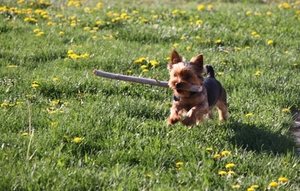Small dogs are just so darn cute, you can’t help swooping them up in your arms and hugging them. Because of their small size, little dogs can get away with a lot more mischief than a larger dog is allowed to do and that puts small dogs at risk of becoming whining and hard to handle. Unfortunately, shelters are full of dogs surrendered to them because their owners didn’t recognize or understand how to correct a behavioral problem their dog developed. Most behavioral issues can be corrected with proper training, patience and leadership. Behavioral problems begin with an owner who never took the time to train or discipline their dog. Discipline isn’t hitting, yelling at, kicking or punishing a dog for bad behavior. It’s correcting a dog through positive training to help him understand how you expect him to act. Small dog syndrome is a dog behavior created by the dog’s owner; not the dog. Keep your small dog out of the shelter by understanding what small dog syndrome is and how you can avoid creating a little monster you can’t handle.
What is small dog syndrome?
As far as dogs are concerned, they are either the leader of the pack or one of the followers. When you bring a small dog home, she assumes you will be the one in charge. However, if she’s allowed to do whatever she wants with no correction from her owner; she begins to believe she’s the one in charge. I’ve dealt with small dog syndrome in one of my little dogs. Riley was about 12 weeks old when she began to show signs she thought she was in charge. One day, she decided she wanted to sit in the spot my black Lab was occupying and challenged him with all the aggression she could muster. He looked at Riley and then looked at me as if asking, “Are you going to take care of this or do I have to?” It was cute to see the smallest dog in the house trying to challenge my biggest dog, but the aggression she was showing had to be dealt with before it got out of hand.
We have a tendency to pick small dogs up whenever they misbehave; which only encourages more bad behavior. The dog learns how to get what she wants and then begins to believe she’s the leader because no one corrected her. All dogs should be treated equally regardless of their size. There’s nothing wrong with picking a little dog up and cuddling with her; as long as it’s on your terms and not hers.
Signs of small dog syndrome
Little dogs allowed to jump up on people, bark, growl, snarl or whine are showing signs of small dog syndrome. They try to compensate for their little size by showing how tough they are whenever they feel stressed, threatened, confused, upset, frustrated, intimidated, or nervous.
Aggression in any size dog should never be tolerated. Small dogs are just as capable of inflicting serious injuries as large dogs. When a dog growls or snaps at other pets or people, she is showing a dominate personality and growling, showing the teeth and snapping is a sign of aggression.
Dogs understand what being in charge means and if she believes the house belongs to her; it’s her right to urinate in the house, on your bed or dig up your prized flower garden. Since the dog is the one in charge, she see no reason why she should obey commands. As far as she is concerned; you are the follower. All dogs should know basic commands like sit, come (recall), stay and down. Training your dog is not dominating her. Teaching her basic commands allows you to keep her under control at all times and understanding how to read a dog’s body language helps you know what your dog is trying to say.
Small dogs can show possessive behavior , can suffer from separation anxiety if left alone too long or bark constantly if someone they don’t know approaches them. When a small dog feels she’s in charge, she compensates with aggression to make herself seem bigger and more fierce. Little dogs usually don’t have a leadership role, but someone has to be in charge and if the owner doesn’t take charge, the dog will take the lead as a defense move to protect herself.
How to correct small dog syndrome
You have to be your dog’s leader. Most dogs would rather follow than lead and have no problem with their owner telling them what to do. Consistent and positive training with proper exercise and discipline, when needed, gives a dog a more relaxed state of mind. When she’s stress free and more balanced, she becomes a well mannered dog. Small dog syndrome is real and can cause a dog to feel stressed out, pick up bad habits and can cause them to be aggressive. When you make it clear you are the leader, your dog can relax and be just a dog knowing you will protect her. Behavior problems can be corrected. Keep your dog out of the shelter and at home where she belongs by learning how to just say “No.”
Body Language of Dogs: Understanding Raised Hackles (Piloerection)
Why Puppy Training is Important for a Puppy’s Healthy State of Mind
What a Dog’s Body Language Tells You About Dog Behavior




